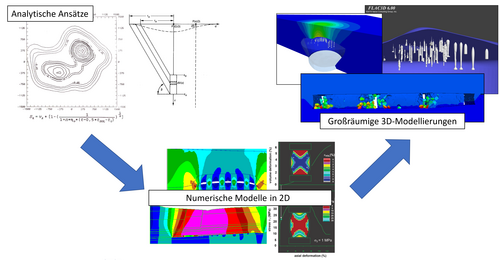The complexity of the models depends on the geomechanical issues and the available data:
- Analytical models (e.g., SENK) can quickly provide subsidence forecasts without having to model entire mine or cavern fields in complex computer models.
- If the system under consideration exhibits approximate symmetries, simplified models can be created, e.g., two-dimensional sections or single-column models.
- More complex situations (e.g., real mining geometries, geological conditions, temporal mining processes) can only be accurately represented in three-dimensional models.
The models can be constructed geometrically in a simplified manner from structured basic elements, or they can replicate mine workings, caverns, and stratigraphy based on available survey data and geological models. To create models from the geodata provided, the IfG uses Rhinoceros® CAD software, which offers versatile options for model construction in 2D and 3D. With Griddle™, this software also includes a robust networking tool. The CAD environment also enables seamless integration with the ITASCA modeling software we use and ensures high-quality conversion of geodata into a numerical model.
| Example of the individual steps involved in modeling a cavern. |

